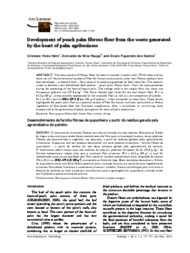Development of peach palm fibrous flour from the waste generated by the heart of palm agribusiness.
Development of peach palm fibrous flour from the waste generated by the heart of palm agribusiness.
Author(s): HELM, C. V.; RAUPP, D. da S.; SANTOS, A. F. dos
Summary: The consumption of fibrous foods has been stimulated in recent years. While wheat and oat brans are still the conventional sources of fiber for human consumption, other new fibrous products have been developed – at research level – from waste or by-products generated by food industries. This research aimed to develop a new dehydrated food product - peach palm fibrous flour - from the waste generated during the processing of the heart-of-peach palm. The average yield in dry weight from this waste into farinaceous products was 129.8 g kg-1. The flours showed high values for the total dietary fiber, 59.1 to 65.5 g 100 g-1, almost entirely represented by the insoluble fiber, as well as a low proportion of calories - 96.1 to 101.1 kcal or 408.2-429.5 kJ per 100 g of product - when compared to wheat bran. These results highlighted the peach palm flour as a potential source of fiber for human nutrition, particularly as fibrous ingredient of formulated food and functional supplements. Also, it contributes to minimizing waste disposal and to the agribusiness of peach palm grown for heart-of-palm production. Keywords: Bactris gasipaes, fibrous food, dietary fiber, nutrition, drying.
Publication year: 2014
Types of publication: Journal article
Unit: Embrapa Forestry
Keywords: Agronegócio, Bactris Gasipaes, Farinha, Fibrous food, Palmito, Pupunha, Resíduo, dietary fiber, drying, nutrition
Observation
Some of Embrapa's publications are published as ePub files. To read them, use or download one of the following free software options to your computer or mobile device. Android: Google Play Books; IOS: iBooks; Windows and Linux: Calibre.
Access other publications
Access the Agricultural Research Database (BDPA) to consult Embrapa's full library collection and records.
Visit Embrapa Bookstore to purchase books and other publications sold by Embrapa.

